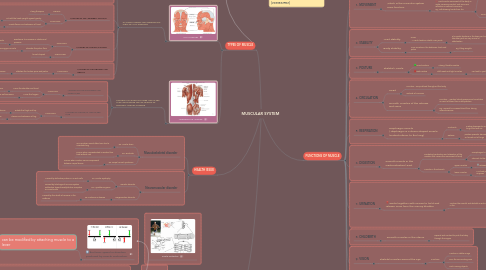
1. TYPES OF MUSCLE
1.1. AXIAL MUSCLES
1.1.1. HAVE BOTH ORIGIN AND INSERTION ON PARTS OF AXIAL SKELETON
1.1.1.1. MUSCLES OF HEAD AND NECK
1.1.1.1.1. ORIGIN
1.1.1.1.2. INSERTION
1.1.1.1.3. FUNCTION
1.1.1.2. MUSCLES OF THE VERTEBRAL COLUMN
1.1.1.2.1. ORIGIN
1.1.1.2.2. FUNCTION
1.1.1.3. MUSCLES OF THE PELVIC FLOOR
1.1.1.3.1. FUNCTION
1.1.1.3.2. STRUCTURE
1.1.1.4. MUSCLES OF THE OBLIQUE AND RECTUS
1.1.1.4.1. FUNCTION
1.2. APPENDICULAR MUSCLES
1.2.1. CONTROL MOVEMENT OF UPPER AND LOWER LIMB AND STABILIZE THE MOVEMENTS OF PECTORAL AND PELVIC GIRDLE
1.2.1.1. MUSCLES OF THE SHOULDERS AND UPPER LIMBS
1.2.1.1.1. FUNCTION
1.2.1.2. MUSCLES OF THE PELVIS AND LOWER LIMB
1.2.1.2.1. FUNCTION
2. MAIN PURPOSES
2.1. MUSCLE CONTRACTION
2.1.1. LEVERS
2.2. LOCOMOTION
2.2.1. RANGE OF MOTION
2.2.2. LOCOMOTION
3. HEALTH ISSUE
3.1. Musculoskeletal disorder
3.1.1. Ex: Muscle strain
3.1.1.1. Occurs when muscle fiber tear due to overstretching
3.1.2. Ex: Tendinitis
3.1.2.1. Occurs when overextended or worked too hard without rest
3.1.3. Ex: Carpal Tunnel Syndrome
3.1.3.1. Occurs when median nerve compressed between carpal bones
3.2. Neuromuscular disorder
3.2.1. Genetic disorder
3.2.1.1. Ex Muscle Dystrophy
3.2.1.1.1. Caused by definitive protein in muscle cells
3.2.1.2. Ex: Myasthenia gravis
3.2.1.2.1. Caused by blockage of immune system antibodies towards acetylcholine receptors on muscle cells
3.2.2. Degenerative disorder
3.2.2.1. Ex: Parkinson's disease
3.2.2.1.1. Caused by the death of neurons in the midbrain
4. the force, speed or direction produced by muscle contraction.
4.1. can be modified by attaching muscle to a lever
4.1.1. first-class lever
4.1.1.1. Ex: Atlanto Occipital Joint
4.1.2. second-class lever
4.1.2.1. Ex: The Calf
4.1.3. third-class lever
4.1.3.1. Ex: Elbow Joint
5. muscle contraction
6. influenced by fascicle organization
6.1. Parallel Muscle
6.1.1. Ex: Biceps Brachii
6.2. Pennate Muscle
6.2.1. (Unipennate) Ex: Extensor Digitorum
6.2.2. (Bipennate) Ex: Rectus Femoris
6.2.3. (multipennate) Ex: Deltold
6.3. Circular/ Sphincter Muscle
6.3.1. Ex: Orbucularis Oris, Orbicularis Oculi
6.4. Convergent Muscle
6.4.1. Ex: Pectoralis Major
7. Muscle origin
7.1. The point where muscles are fixed either to a bone, cartilage or connective tissue
8. Muscle insertion
8.1. The site where muscles move and are attached to other structure
9. FUNCTIONS OF MUSCLE
9.1. 1. MOVEMENT
9.1.1. Which is the muscular system main function
9.1.1.1. Most muscle movement of the body is under conscious control. But some are reflective or without conscious, eg ; withdrawing hands from fire
9.1.1.1.1. Gross movement
9.1.1.1.2. Fine movement
9.2. 2. STABILITY
9.2.1. Joint stability
9.2.1.1. How? - Muscle tendons stretch over joints
9.2.1.1.1. p/s muscle tendons in the knee joint and shoulder joint are very crucial in stabilization
9.2.2. Body stability
9.2.2.1. Core muscles in the abdomen, back and pelvis
9.2.2.1.1. Eg. lifting weights
9.3. 3. POSTURE
9.3.1. Skeletal Muscle
9.3.1.1. Good Posture
9.3.1.1.1. Strong, flexible muscles
9.3.1.2. Bad Posture
9.3.1.2.1. Stiff, weak and tight muscles
9.4. 4. CIRCULATION
9.4.1. Heart
9.4.1.1. Function : Pumps blood throughout the body
9.4.1.2. Outside of concious
9.4.2. Smooth Muscles of the arteries and veins
9.4.2.1. Function : Maintain blood pressure and circulation in event of blood loss or dehydration
9.4.2.2. Eg : expand to increase blood flow during intense exercise
9.5. 5. RESPIRATION
9.5.1. Diaphragm muscle ( diaphragm is a dome shaped muscle located inferior to the lung)
9.5.1.1. Contracts
9.5.1.1.1. Pushes downwards, increasing chest cavity, lungs filled with air
9.5.1.2. Relaxes
9.5.1.2.1. pushes upwards, decreasing chest cavity, air forced out of lungs
9.6. 6. DIGESTION
9.6.1. Smooth muscle in the Gastrointestinal Tract
9.6.1.1. Peristalsis (contraction and relaxation of the muscles that causes the movement of food)
9.6.1.1.1. Oesophagus to the stomach
9.6.1.1.2. Stomach to the intestines
9.6.1.2. Muscles in the stomach
9.6.1.2.1. upper muscles
9.6.1.2.2. lower muscles
9.7. 7. URINATION
9.7.1. works together with nerves to hold and release urine from the urinary bladder
9.7.1.1. Involves the smooth and skeletal muscles in the
9.7.1.1.1. Bladder
9.7.1.1.2. Kidneys
9.7.1.1.3. Penis or vagina
9.7.1.1.4. Prostate
9.7.1.1.5. Ureter
9.7.1.1.6. Urethra
9.8. 8. CHILDBIRTH
9.8.1. Smooth muscles in the uterus
9.8.1.1. Expand and contract to push the baby through the vagina
9.9. 9. VISION
9.9.1. Skeletal muscles around the eye
9.9.1.1. Functions
9.9.1.1.1. Maintain a stable image
9.9.1.1.2. Scan the surrounding area
9.9.1.1.3. Track moving objects
9.10. 10. ORGAN PROTECTION
9.10.1. Muscles in the whole body
9.10.1.1. Protects internal organs and bones
9.10.1.1.1. How?
9.11. 11. TEMPERATURE REGULATIONS
9.11.1. Almost 85% of the heat generate by a person are caused by the cotraction of the muscles
9.11.1.1. When heat below optimum level
9.11.1.1.1. Skeletal muscles increase their activity to generate heat
9.11.1.1.2. Muscles in the blood vessels contract to avoid heat loss
9.11.1.2. When heat above optimum level
9.11.1.2.1. Muscles of the blood vessels relaxes to increase blood flow and release heat
